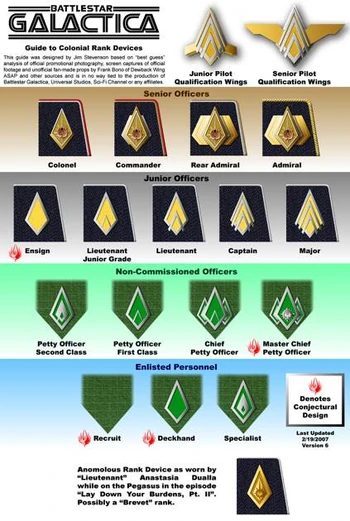
The Ranks of the Battlestar Galactica Universe might confuse those familiar with the modern day rank system. For the most part, the ranking system follows basic principles of modern militaries, but notably several enlisted and NCO ranks are missing while there are added and mixed ranks in the officer ranks.
BSG does a fairly decent job at butchering the rank system. The below is an attempt to act as a basic guideline. Nothing is set in stone and it certainly doesn't perfectly mimic RL military.
Commissioned Officer[]
All officers hold a commission from the Colonial government. They receive the authority of their offices from this source and through that authority they command.
The following list includes: Rank (Designation) - age requirement - years in service brief description of standard posting. These numbers are a guideline. Also, keep in mind that the military promotes on ability, not merely seniority. Just because one has time in service it does not mean that a promotion is deserved.
Most officers first attend a four year institution (either a military academy or ROTC program through a college). Others are "mustangs" who started as enlisted and quickly worked their way through the ranks and earned a merit-based commission. Others still merely attend a brief Officer Candidate School before being commissioned. How one became an officer is not terribly important in the low ranks but it does become more important for higher rank promotions.
The base age number below assumes an officer that either went to an academy or through an ROTC program, starting their education and military service at the age of eighteen. The "standard posting" example if for a Battlestar. Those officers aboard a Gunstar will generally be a rank below (e.g. the ship will be commanded by a Colonel not a Commander), and a Patrolstar might be a rank below that (i.e. commanded by a Lieutenant Colonel). Department heads will thus be relatively lower as well. A major on a large Battlestar will generally command the same number of people as a major on a small Patrolstar. However, the Patrolstar has fewer people overall and thus fewer majors overall.
- Admiral (O-10) - 47–25 Commands several Battlestar groups.
- Rear Admiral (O-9) - 42–20 Commands a Battlestar group and related vessels.
- Commander (O-8) - 37–15 Commands a Battlestar.
- Colonel (O-7) - 34–12 Second in command.
- Lieutenant Colonel (O-6) - 31–9 Senior department head.
- Major (O-5)- 29–7 Junior department head.
- Captain (O-4) - 26–4 Senior frontline commander.
- Lieutenant (Senior Grade) (O-3) - 24–2 Most common officer rank – mid level.
- Lieutenant (Junior Grade) (O-2) - 23-0.5 Low level officer
- Ensign (O-1)- 22–0 Freshly minted officer
- Cadet (O-0) - 18-N/A Officer in training*
- A cadet's rank in relation to enlisted ranks changes as the cadet progresses through training. They are not technically an officer until they are promoted to ensign, but they are certainly more than mere recruits. A senior cadet will be about the equivalent of an E-4 or E-5.
Warrant Officer[]
WOs are issued a "warrant" rather than a commission. The warrant and oath need not be "as official" as a commission but often they are identical in all but name. Officers serving under a warrant are technical experts in a state of limbo between the enlisted below and the other officers above. Of note, warrant officers technically rank above cadets (in between O-0 and O-1) no matter how far along the cadet is in training.
Warrant officers will get their start in the enlisted ranks and are essentially plucked out of that rank system entirely and often skip the NCO ranks.
- Warrant Officer (W-1) - 24-6 Technical expert in various fields performing tasks or handling machinery that is not deemed appropriate for enlisted personnel.
Non-Commissioned Officer[]
NCOs are enlisted personnel that have been promoted to positions of increased authority and responsibility but lack an actual commission. They do not have "command" but merely have a "charge."
Again, the following list includes: Fleet Rank/Marine Rank (Designation) - age requirement - years in service brief description of standard posting/marine posting. These numbers are a guideline. Also, keep in mind that the military promotes on ability, not merely seniority. Just because one has time in service it does not mean that a promotion is deserved.
All NCOs start in the list below with 18 as the assumed starting age (straight out of high school/upon reaching adulthood) but of course not all careers begin at that age.
- Master Chief Petty Officer/Master Sergeant (E-7) - 33-15 Uncommon rank, senior most NCO
- Chief Petty Officer/Gunnery Sergeant (E-6) - 28–10 NCO head of a department/Company sergeant
- Petty Officer First Class/Sergeant First Class (E-5) - 25–7 NCO team leader/Platoon sergeant
- Petty Officer Second Class/Crew Sergeant (E-4) - 22–3.5 NCO assistant team leader/Squad leader
Enlisted Personnel[]
Those who have "enlisted" with the military. They hold no commission nor have they been given a charge through promotion to NCO.
- Specialist/Corporal (E-3) - 20–1.5 Senior and typically skilled enlisted/Fireteam leader
- Crewman/Private First Class (E-2) - 19–0.5 Standard enlisted
- Crewman Apprentice/Private (E-1) - 18–0 Brand new enlisted
- Crewman Recruit/Recruit (E-0) - New recruits still in training
Military Positions[]
In addition to basic ranks, there are also numerous Military Positions. Some of these are fairly standard specializations like "deckhand" or "marine" which merely connote one's department and basic job. Others like "Master-at-Arms" or "Deck Chief" are added positions of responsibility. These special positions of authority can be considered half-steps to the next rank. An E-6 with such a title is more senior to one without.